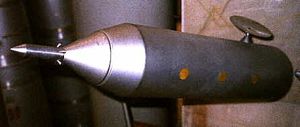
Home - Search - Browse - Alphabetic Index: 0- 1- 2- 3- 4- 5- 6- 7- 8- 9
A- B- C- D- E- F- G- H- I- J- K- L- M- N- O- P- Q- R- S- T- U- V- W- X- Y- Z
MK-700
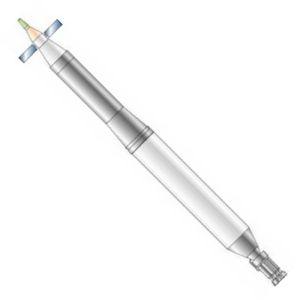 MK-700 Credit: © Mark Wade |
Status: Study 1972. Gross mass: 1,400,000 kg (3,000,000 lb). Specific impulse: 900 s. Height: 140.00 m (450.00 ft). Span: 20.00 m (65.00 ft).
He proposed two launches of the enormous UR-700M launch vehicle to assemble a 1400 metric ton MK-700 spacecraft in earth orbit. Nuclear thermal stages allowed a net functional payload (living quarters, Mars landers, earth return capsule) of 250 metric tons.
A government expert commission reviewed the preliminary draft project for the UR-700M launch vehicle and MK-700 spacecraft in 1972. Based on the decades worth of development and tens of billions or rubles required, the state commission recommended that further work on manned Mars expeditions be deferred indefinitely.
In the post-Apollo moon landing euphoria, NASA was pressing for funding for a manned expedition to Mars. The Soviet leadership reacted in kind. Development of an advanced project for the MK-700 was authorized in Ministry of Defense decree 232 of 30 June 1969. The TTZ specification document was written by the TsNIIMASH and NIITI institutes, and the project was given the code name 'Aelita'. The TTZ called for a Mars expedition spacecraft of 1,500 metric tons mass.
Analysis of the requirement indicated a larger launch vehicle than that required by the TTZ would be optimum. Opportunities for launches to Mars had limited launch windows at two year intervals. The combined probability of successfully launching, docking, and assembling a half dozen payloads in low earth orbit was relatively low. The optimum chance for mission success was to use no more than one or two dockings in earth orbit. (NASA came to a similar conclusion in the early 1960's, leading to the Nova launch vehicle studies). Chelomei used a modular approach to the launch vehicle design in order to achieve payloads of 300 to 800 metric tons. By the advanced project stage the MK-700 assembly sequence had been reduced to two variants:
- Variant 1: A launch vehicle with a payload of 750 to 800 metric tons payload (requiring two launches and one docking in earth orbit to assemble the 1,500 metric ton MK-700 spacecraft). This was the preferred variant.
- Variant PA: Launch vehicle with 480 to 520 metric ton payload, requiring three launches and two dockings to assemble the spacecraft.
Further studies by Section p/Ya A-1233 of Chelomei's TsKBM managed to reduce the mass of the spacecraft for the Mars expedition to 900 to 1,.000 metric tons. This allowed the PA variant booster to be used with just two launches and one docking.
Planned flight trials before the Mars expedition would include moon base tests, ballistic and re-entry tests of the MK re-entry capsule in near-earth space, and a final shakedown flight of the complete complex to the moon and back.
A government expert commission reviewed the preliminary draft project in 1972. Two variants were presented:
- Variant 1 used 40 metric ton and 3.6 metric ton thrust nuclear rocket engines in the upper stages. It required delivery of 1,400 metric tons of payload to low earth orbit, requiring two UR-700M launches and one docking.
- Variant 2 used Lox/LH2 chemical propulsion in the upper stages. It would require delivery of 2,500 metric tons into earth orbit, using four UR-700M launches and three dockings.
The first variant was the preferred option. The MK-700 spacecraft design was represented by a model in the TsNIIMASH museum. This indicates that it consisted, from fore to aft:
- Launch 1: MK-700 Spacecraft. This consisted of:
- VA re-entry capsule, a stretched version of that used in the LK-1 and LK-700 lunar spacecraft and TKS manned orbital ferry designs. Access from the capsule to the living quarters would have been through a hatch in the heat shield. Base diameter of the VA was about 5 m.
- Living/equipment module, 15 m long and with a diameter of 10 m. This was presumably the living quarters for the crew. It was equipped with solar panels with a span of 20 m. These would have provided auxiliary power in case of failure of the nuclear power plant and/or during the return of the spacecraft from Mars. The VA and Equipment Module were covered by a payload fairing during ascent to orbit and were presumably topped with a large launch escape tower to pull the VA away in case of a launch vehicle emergency.
- Primary module 10 m in diameter and 45 m long. This assembly would have included the Mars lander , probes, and the cruise/Mars maneuvering nuclear stage. At the base was a flared interstage that would have docked with Launch 2 portion of the spacecraft in earth orbit. The propulsion stage would have had a mass of about 450 metric tons and the VA, Equipment module, lander, and probes about 250 metric tons.
- Launch 2: The second module would probably be a 700 metric ton trans-Mars injection stage, 12.5 m in diameter and about 75 m long.
- The problem of crew survival for 650 days on the voyage to Mars had not been solved. 12 to 15 years of studies of the affects of space on human beings would be required aboard space stations in earth orbit before this would be possible.
- Nuclear engines for the first variant were only in the draft project stage. It would take 15 to 20 years to reach technological maturity.
- The radiation safety problem of nuclear thermal propulsion had only been solved theoretically. Negotiations with the United States would be required to achieve international permission for placing large nuclear reactors into orbit. The outcome of these negotiations was uncertain.
- Variant 2, requiring 2,500 to 3,000 metric tons of payload, was technically and legally more achievable, but the mass to be placed in orbit was unrealistic.
- Total program would cost 30 to 40 billion rubles at 1973 prices. The Soviet Union did not have the resources to pursue a project of that size.
Some sources indicate Chelomei proposed yet again a single-launch Mars flyby expedition in 1974. This would be launched on the UR-900 or a more modest version of the UR-700M, with a low earth orbit payload of 250 metric tons. A crew of two in an MK-700 spacecraft would spend two years on a flight to Mars and then return to earth using the re-entry capsule developed for Chelomei's TKS orbital ferry.
MK-700 Mission Summary:
- Summary: First Soviet nuclear thermal Mars expedition design.
- Propulsion: Nuclear thermal
- Braking at Mars: propulsive
- Mission Type: opposition
- Split or All-Up: all up
- ISRU: no ISRU
- Launch Year: 1980
- Crew: 2
- Outbound time-days: 300
- Mars Stay Time-days: 30
- Return Time-days: 300
- Total Mission Time-days: 730
- Total Payload Required in Low Earth Orbit-metric tons: 1400
- Total Propellant Required-metric tons: 900
- Propellant Fraction: 0.64
- Mass per crew-metric tons: 700
- Launch Vehicle Payload to LEO-metric tons: 520
- Number of Launches Required to Assemble Payload in Low Earth Orbit: 3
- Launch Vehicle: UR-700M
Crew Size: 2.
Family: Mars Expeditions, Mars flyby. Country: Russia. Launch Vehicles: Mars tactical rocket, UR-700, UR-700M. Propellants: Nuclear/LH2. Projects: Mars. Agency: Chelomei bureau. Bibliography: 122, 367, 443, 474, 73.
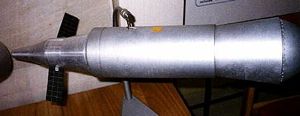 | MK-700 Mars craft MK-700 manned Mars spacecraft designed by Chelomei in 1970's Credit: Andy Salmon |
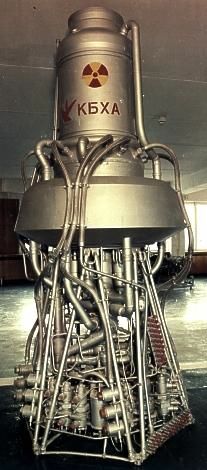 | RD-0410 NTP Engine RD-0410 Nuclear Thermal Engine Credit: © Dietrich Haeseler |
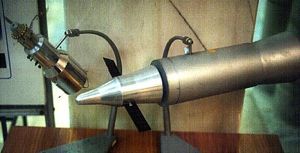 | Salyut and MK-700 Salyut and MK-700 models Credit: © Mark Wade |
1969 June 30 - . Launch Vehicle: UR-700M.
- MK-700/UR-700M manned Mars expedition development approved. - .
Nation: Russia.
Spacecraft: MK-700.
Ministry of General Machine Building (MOM) Decree 232 'On start of work on the UR-700M rocket' was issued. The decree allowed development of an advanced project for a manned Mars expedition using the UR-700M booster and MK-700 spacecraft. The TTZ specification document was written by the TsNIIMASH and NIITI institutes, and the project was given the code name 'Aelita'.
1969 July 30 - . Launch Vehicle: UR-700M.
- Soviet manned Mars spacecraft study - .
Nation: Russia.
Related Persons: Chelomei.
Spacecraft: Aelita satellite,
MK-700.
As a result of the VPK meeting of 29 May, a decree was issued, instructing Chelomei to complete a draft project within the year for a Mars manned space mission, using as the booster his UR-700M (or UR-900) design, and his MK-700M spacecraft. It was not until August 1997 that Igor Gansvindt revealed that during the 1960's he had developed a system for navigation and guidance for a piloted landing on Mars and its return to earth. This work preceded Aleksei Tolstoy's Aelita project of 1975.
1972 During the Year - . Launch Vehicle: UR-700M.
- Soviet Mars expedition work ends - .
Nation: Russia.
Related Persons: Chelomei.
Spacecraft: MK-700.
Chelomei's preliminary draft project for the UR-700M launch vehicle and LK-700 spacecraft was reviewed by a government expert commission. Based on the decades worth of development and tens of billions or roubles required to realise the project, the state commission recommended that further work on manned Mars expeditions be deferred indefinitely.
1975 January 1 - . Launch Vehicle: UR-700.
- Chelomei presents plan for Mars mission - .
Nation: Russia.
Related Persons: Chelomei.
Class: Mars.
Type: Manned Mars flyby. Spacecraft: MK-700.
As the only remaining contender for the Aelita design competition, Chelomei proposes a Mars flyby using an MK-700 spacecraft. A crew of two would be sent on a two year mission in a single launch of a UR-700M booster. The spacecraft would have a mass of 250 tonnes in low earth orbit and be equipped with an RD-410 nuclear engine.
Back to top of page
Home - Search - Browse - Alphabetic Index: 0- 1- 2- 3- 4- 5- 6- 7- 8- 9
A- B- C- D- E- F- G- H- I- J- K- L- M- N- O- P- Q- R- S- T- U- V- W- X- Y- Z
© 1997-2019 Mark Wade - Contact
© / Conditions for Use
